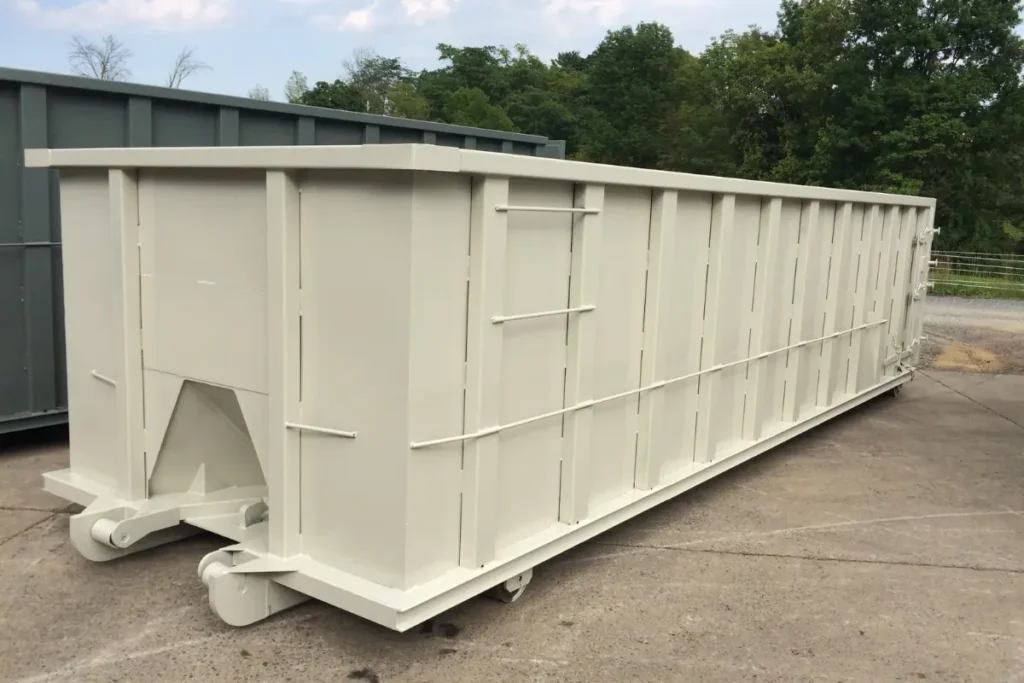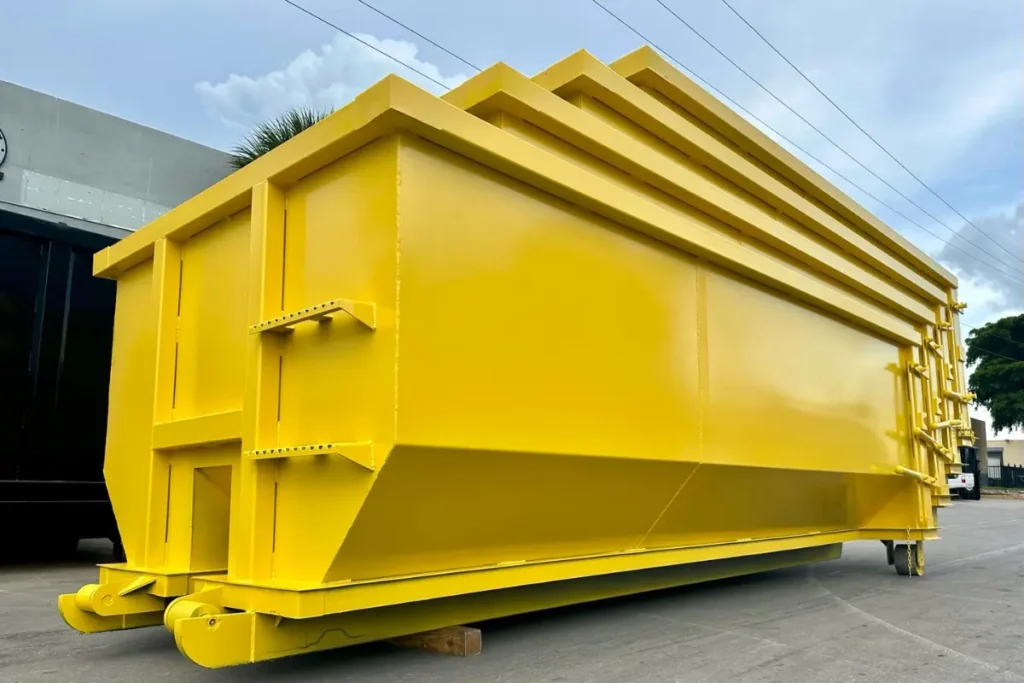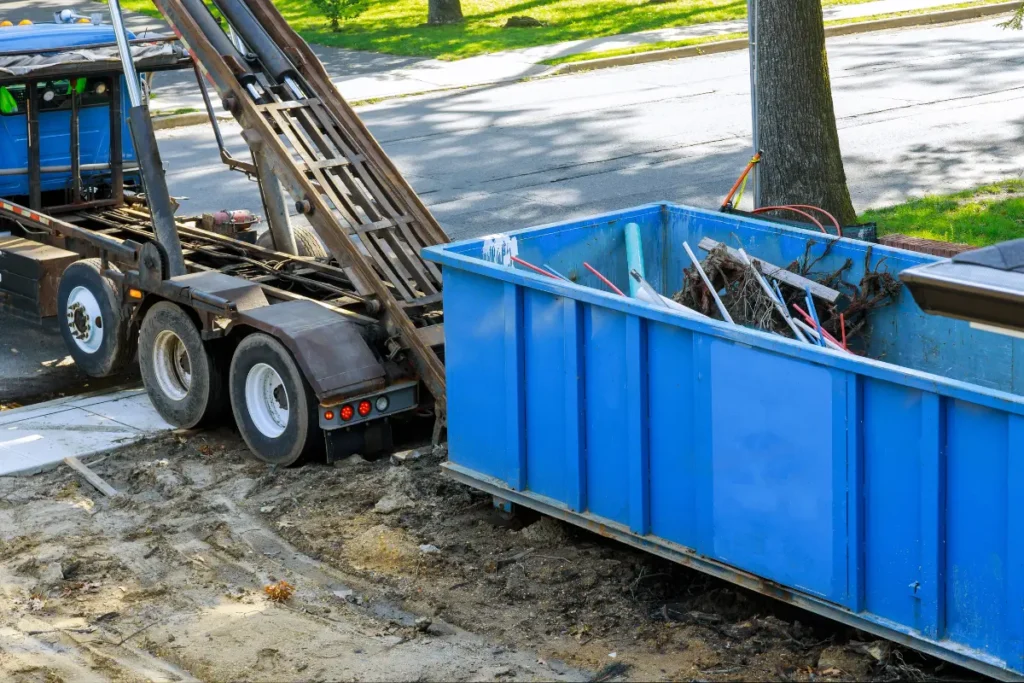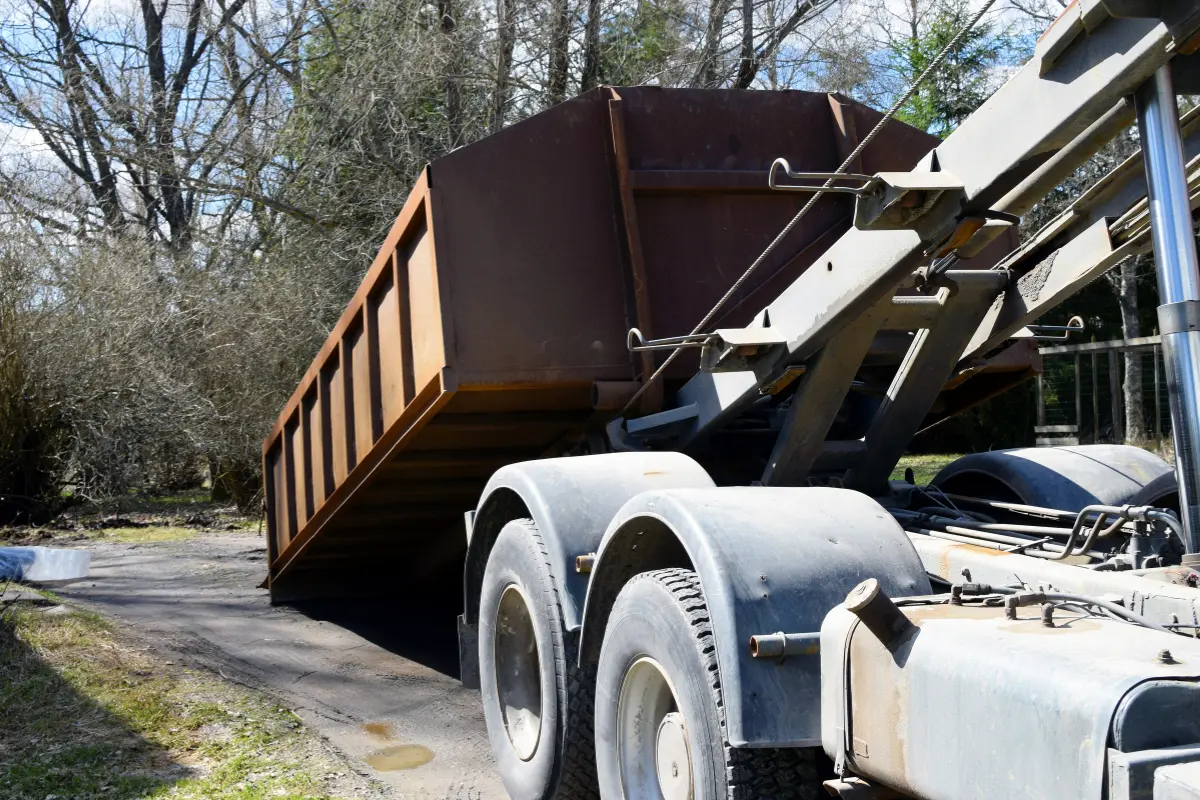Roll-off containers are a versatile and robust solution for managing materials and waste on construction and work sites. These are designed for easy transportation and can be rolled off a specialized truck onto the job site, making them ideal for storage and disposal. Their importance stems from their ability to handle large volumes of waste materials, debris from demolition, or excess construction materials, ensuring a clean and safe environment. Such capability simplifies job site storage solutions and enhances safety and compliance with environmental regulations.
The Role of Roll-Off Containers in Job Site Storage
Improve Storage Efficiency
It dramatically enhances storage efficiency on construction sites by allowing easy access to tools, equipment, and materials. Their design features a top-open layout that enables quick loading and unloading, crucial for maintaining momentum during busy construction phases. Such an efficiency boost is particularly valuable in large-scale projects with critical time and space management. Moreover, these containers can be conveniently positioned and relocated within the site as needed, reducing unnecessary movement of materials and minimizing labor costs.
Secure Storage Solutions
The security features make them an excellent choice for theft-resistant storage container options at job sites. Equipped with locking mechanisms and made from tough materials, they provide a secure space for storing valuable tools and machinery, reducing the theft risk. Additionally, the solid construction of these containers protects contents from environmental damage, such as rain or wind, thus safeguarding expensive equipment and materials from weather-related deterioration.
Applications Beyond Storage
They are also indispensable for waste disposal containers, facilitating the segregation and removal of construction debris, which helps maintain environmental compliance and reduce potential hazards on the site. A dual function not only simplifies operations but also aids in adhering to local regulations regarding waste management, proving that these containers are a multipurpose solution ideal for modern construction needs.

Benefits of Renting Roll-Off Containers
Cost-Effectiveness
Renting a roll-off container is a cost-effective solution for many project managers. Rentals eliminate the need to purchase permanent containers, which can be expensive and unnecessary for temporary projects. These options also include maintenance and delivery, which further reduce the logistical burdens and associated costs of managing construction site storage. By using rental services, construction managers can allocate resources more efficiently and avoid the capital expense of owning and storing containers when they are not in use.
Flexibility and Convenience
The nature of construction and other dynamic work environments often requires adaptable storage solutions. Roll-off containers provide this flexibility, allowing for quick deployment and easy relocation around the site as needs change. Whether expanding the storage area or shifting focus to different aspects of the project, these containers can be easily moved without disrupting the site’s workflow. This adaptability makes them particularly valuable for projects with evolving storage needs.
Environmental Benefits
They are a practical solution for managing large amounts of waste and contribute positively to the environment. These provide a reliable method for waste management, reducing environmental harm and encouraging greener practices. Below are the key environmental benefits of roll-off containers, expanded in detail:
- Reduction in Waste Generation: Constructed to be durable and long-lasting, which minimizes the need for frequent replacements, this longevity reduces the production of new containers, lowering the demand for raw materials and energy consumption. Also, the use of these containers encourages better waste sorting practices on-site, preventing unnecessary waste from being generated. Contractors and site managers can plan waste disposal more effectively, reducing overproduction and the associated environmental costs.
- Lower Carbon Emissions: By streamlining waste management processes, roll-off containers help reduce carbon emissions. Their large capacity ensures fewer trips are needed for transporting waste, cutting down on fuel usage and greenhouse gas emissions. Companies that employ these often optimize their transportation routes to further decrease environmental impact, showcasing a commitment to eco-friendly practices. Reduction in emissions aligns with the goals of sustainable development in construction and industrial projects.
- Enhanced Recycling Capabilities: One of the standout features of roll-off containers is their ability to support efficient recycling. Their design often includes compartments or space for sorting recyclable materials such as wood, metal, and concrete. This makes it easier to segregate construction debris on-site, ensuring that recyclable materials are sent to the appropriate facilities rather than ending up in landfills. A systematic approach promotes recycling and reduces the strain on natural resources.
- Decreased Landfill Impact: Proper handling and organization of debris ensure that non-recyclable waste is disposed of responsibly while recyclable materials are diverted for reuse. This helps preserve landfill space and reduces environmental hazards, such as soil and water contamination, caused by excessive waste buildup. Projects that use roll-off containers contribute to a cleaner, more sustainable environment.
- Use of Recycled Materials in Manufacturing: Many roll-off containers are manufactured using recycled steel, highlighting their contribution to a circular economy. By repurposing materials, manufacturers reduce the demand for virgin steel, saving energy and decreasing carbon emissions associated with production. An environmentally conscious approach to manufacturing further enhances sustainability and supports industries striving to lower their ecological footprint.
Incorporating roll-off containers into waste management plans streamlines operations and significantly reduces environmental impact. These containers represent a practical, eco-friendly solution for construction sites, industrial projects, and other large-scale waste-generating activities. By choosing these, businesses can demonstrate their commitment to sustainability and contribute to a greener future.
Choosing the Right Roll-Off Container for Your Project
Assessing Roll-Off Container Sizes
It comes in various sizes, typically measured in cubic yards, which cater to both small renovations and large-scale construction projects. Selecting an appropriately sized container minimizes costs and optimizes space utilization on the job site. Smaller projects may only require a 10-yard container, which is ideal for minor cleanup activities. In contrast, large projects might need 30-yard or 40-yard containers capable of handling substantial amounts of waste and debris from construction activities.

Portable Storage Options
Portable storage for construction sites is essential for maintaining organization and efficiency. Roll-off containers are perfect for this purpose, providing a mobile storage solution that can be adapted to the scale of the project. Their portability allows them to be placed strategically across the site, ensuring that materials are accessible wherever needed, particularly useful in large areas or multiple job site locations.
Evaluating Features
It’s important to consider features that enhance security and accessibility. Many containers come equipped with lockable doors to secure materials and tools, which are crucial for preventing theft and unauthorized access. Some equipment storage units feature easy-access doors that facilitate the loading and unloading of heavy or bulky items, making them user-friendly and reducing strain on the workforce.
Matching Container Type to Project-Specific Requirements
Each project has its own requirements, from waste type and duration to budget and environmental concerns. Selecting the right roll-off container involves evaluating these factors carefully. Below, we expand on five critical considerations to guide your decision-making process:
- Waste Type: The type of waste your project generates directly influences the container choice. Durable and specialized containers are necessary for hazardous or heavy materials to ensure safety and compliance with regulations. For instance, projects involving construction debris or hazardous chemicals require roll-offs with reinforced materials to handle the weight or prevent leaks. Understanding the nature of your waste helps mitigate risks and ensures proper disposal methods are followed.
- Site Accessibility: Site-specific constraints can dictate the type of container that is suitable. Narrow driveways, low-clearance areas, or uneven terrain may require smaller, maneuverable containers. Conversely, open spaces may accommodate larger containers that optimize storage capacity. Considering how the container will be delivered, positioned, and accessed during the project ensures efficiency and avoids delays caused by logistical issues.
- Project Duration: The length of your project impacts the container’s wear and tear, as well as its capacity needs. For extended timelines, opt for durable containers that can withstand prolonged use without compromising structural integrity. Additionally, consider whether multiple pickups or container swaps will be necessary to keep the site clean and prevent overflow, especially during phases with higher waste generation.
- Environmental Considerations: Sustainability-focused projects benefit from containers made of recycled materials or those designed to minimize environmental impact. Lightweight models that reduce fuel consumption during transport or containers with energy-efficient handling features align with eco-friendly goals. Evaluating these options demonstrates a commitment to reducing your project’s carbon footprint.
- Budget Constraints: While specific features enhance convenience, they often come at a cost. Balancing the need for functionality against your budget ensures you receive the best value. For example, opting for a standard roll-off container without additional customization may save costs for general waste, while specialized containers might be a justified expense for projects requiring strict compliance.
By thoroughly evaluating these aspects, project managers can ensure they select the storage container rental services that best fit their site’s demands, enhancing overall project efficiency and effectiveness.
Streamlining Logistics with Roll-Off Container Transport
Simplify Delivery and Relocation
The logistical advantage of roll-off containers lies in their design, which simplifies both delivery and relocation on the job site. These containers have wheels and a special roll-off system that allows them to be easily transported and positioned exactly where needed. This feature is particularly beneficial on large construction sites or where the container needs to be moved as the project progresses. It ensures that storage is always in the most convenient location, enhancing job site efficiency and reducing handling time.
Managing Container Removal Post-Project
The same roll-off technology aids in their delivery and allows for their efficient removal. This is a crucial aspect of site demobilization, as timely clearing of the site helps transition it back to normal or prepare it for the next development phase. Efficient container removal is also part of maintaining a good relationship with the local community by minimizing the impact of construction activities.
Reducing Downtime
The ability to quickly place and replace containers as needed helps maintain a steady workflow, which is essential for meeting project timelines and budgets. The containers’ design for easy loading onto transport vehicles means they can be offloaded, filled, and removed without significant delays, keeping the project on schedule and avoiding any logistical bottlenecks.
Compliance with Transportation and Placement Rules
Roll-off container transport must comply with local transportation and safety regulations, which govern container placement and movement within public spaces. Adherence to these rules is vital to avoid legal issues and ensure the safety of both the public and workers on the site. Effective compliance involves planning routes, securing necessary permits, and using appropriate warning signs and barriers when containers are placed in sensitive or high-traffic areas.
Comparing Roll-off vs. Standard Containers
Key Differences in Durability and Portability
Designed to withstand the rigorous demands of construction sites, roll-off containers are made from high-grade, tough materials that resist dents, corrosion, and other forms of wear and tear. This makes them suitable for heavy-duty storage for work sites and waste management tasks. The roll-off design also facilitates easy movement and positioning, which is not as seamless as standard construction containers that often require additional equipment for transport.
Adaptability for Temporary vs. Long-Term Storage
They can be quickly deployed for short-term projects yet are robust enough to serve for extended periods without frequent maintenance. In contrast, standard containers, while suitable for long-term storage, often lack the flexibility needed for short-term, dynamic construction projects where storage needs can change rapidly as the project develops.
Ease of Use for Work Site Needs
Workers can easily access the contents without additional loading equipment, which is often not the case with standard containers that may require ramps or forklifts for access. Such ease of use enhances productivity by saving time and reducing labor costs associated with managing site resources.

Affordability and Value for Money
When considering cost-effectiveness, roll-off containers offer significant value for money, especially when the full scope of their benefits is considered. They provide a high level of utility and flexibility, which can reduce overall project costs by minimizing waste and improving site efficiency. Standard containers might have a lower upfront cost, but the additional expenses for transport, setup, and less versatility can make them less economical throughout a project.
Selecting the right roll-off container rental is crucial for maximizing the benefits it can offer your project. When choosing a container, consider the specific needs of your job site, including the volume of materials to be handled, the nature of the waste, and the site layout. It’s also important to partner with a reputable rental company that offers a range of container options and dependable service. Ensure that the chosen provider can deliver and pick up the containers as scheduled and provide support for any issues that may arise. Attention to detail will help ensure your project runs smoothly, with minimal disruption and maximum efficiency.

 Receive a Quick Quote
Receive a Quick Quote


 ” -Zachary
” -Zachary